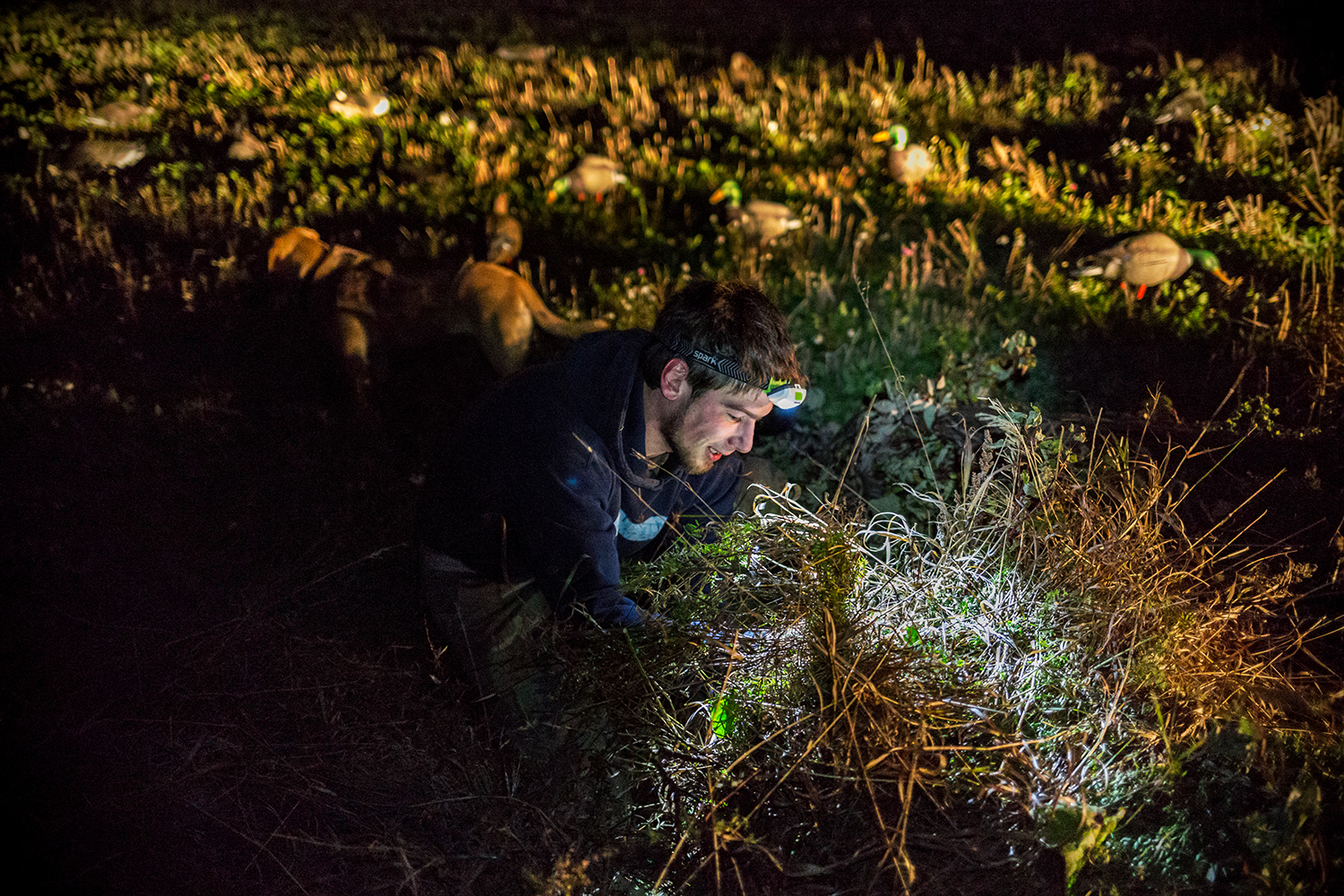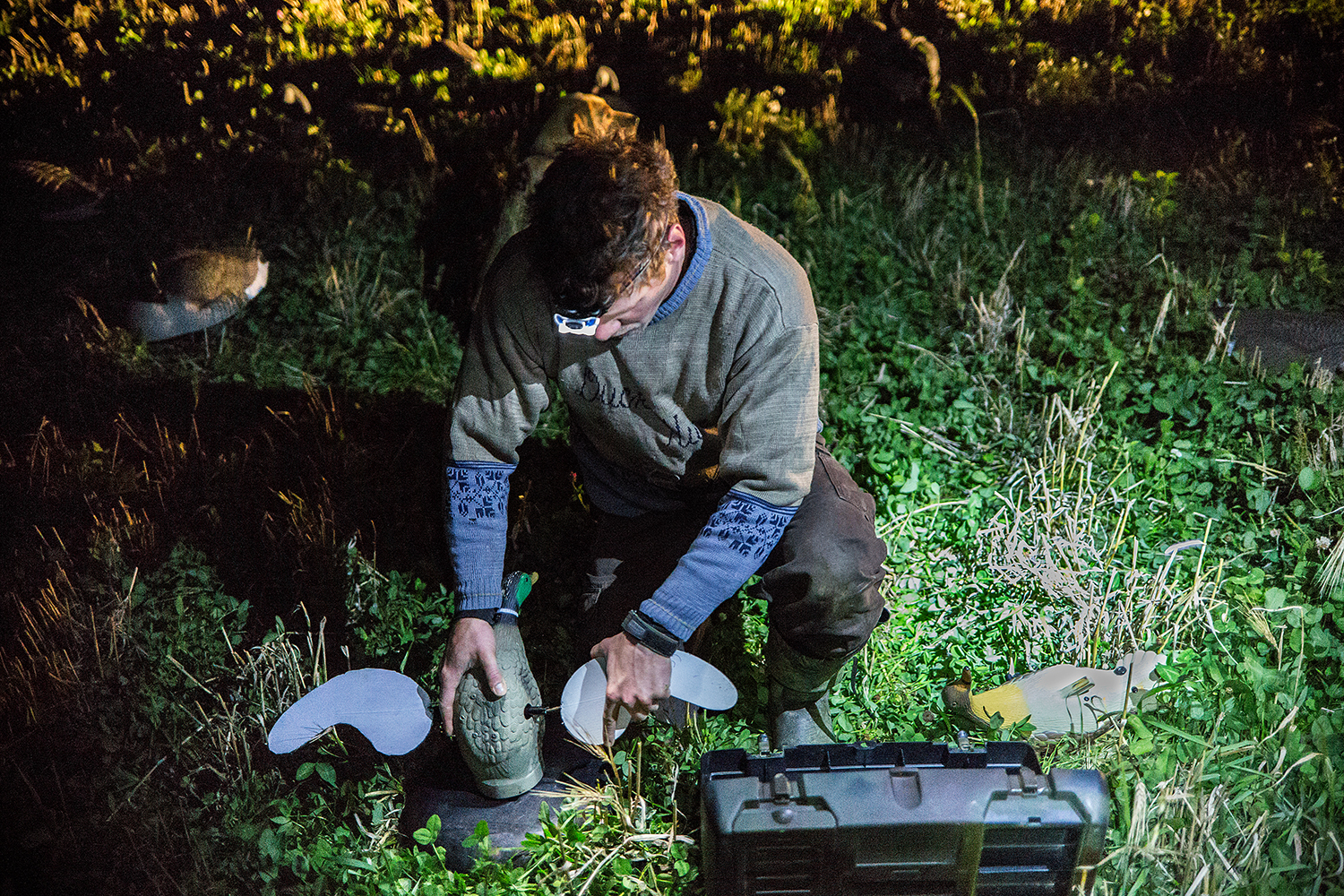Passer les oies sauvages
Il est trois heures
quinze du matin et la sonnerie de mon réveil m’ordonne de me
lever. Je me douche, déjeune, finis de me préparer et sors
rejoindre mon ami chasseur Jean Sébastien qui m’a donné
rendez-vous en bas de chez moi à quatre heures quinze. Nous
retrouvons son ami Guillaume et arrivons dans deux grands champs déjà
récoltés au bord du fleuve Saint-Laurent passé le village de
Petit-Matane. Aujourd’hui, nous chassons la sauvagine : oies
blanches, outardes et canards. Il nous faut faire vite, nous avons
environ une heure pour installer les appelants, couper des herbes
pour le camouflage des cages tombeaux, stationner les voitures à
l’entrée du champ et armer les fusils en nous camouflant dans la
cage.
Le soleil se lève
lentement, il est cinq heures trente et le premier canard vient de
passer au-dessus de nous. La chasse est une question de minute! Nous
sommes à l’affût, au loin arrivent par centaine, des bataillons
d’oiseaux, c’est alors que le travail des chasseurs prend tout
son sens. Outre les oiseaux en plastiques servant de leurre et le
fait d’être entièrement caché, la chasse à l’oiseau migrateur
est avant tout une technique d’appel de l’animal. Je ne sais plus
où donner de la tête, je suis submergé par les émotions,
j’assiste à une véritable parade aérienne. Le soleil surgit de
derrière les collines au loin, pour refléter dans les plumages des
bêtes qui se découpent dans le ciel d’un bleu impeccable. Les
animaux à bec font alors des vrilles et autres acrobaties pour
chercher à trouver d’où proviennent les « Calls » des
chasseurs. C’est alors qu’une descente d’oies est en approche
vers nous, j’entends le décompte de Guillaume pour sortir des
caches.
Je me prends au jeu,
sortir de ma cache, pointer mon appareil photo et presser sur le
déclencheur comme la détente d’un 12mm. C’est à ce moment
précis que je réalise la beauté du geste et la dureté de la
traque incessante pour tuer l’animal. L’oie se cabre, freine des
ailes cherchant à faire un demi-tour et éviter le danger. Il est
toutefois trop tard, les plumes volent à même les coups de fusil.
Le chien part en courant sur les dépouilles gisant au sol pour
s’empresser de les rapporter à son maître. Pendant plusieurs
heures, nous assisterons à ce même défilé d’oiseaux migrateurs
à la recherche des dernières graines laissés dans ces champs
vides. Il est l’heure de faire les comptes et de ranger nos
affaires, il est onze heures et nous partons chez Guillaume pour
faire le dé-plumage des animaux. Tout est méticuleusement découpé,
nettoyé, puis emballé.
Octobre 2014 ©
Photographe : Thibaut Ketterer
Look at the wild geese
A
few weeks later, the sky was dark and the stars were twinkling on the
horizon. It is 3.15 am and my alarm clock orders me to wake up. I
take a shower; have a breakfast, get ready and go out to meet my
friend Jean Sebastien, a hunter, who asked me to meet up in front of
my place at 4.15 am. We gather with his friend Guillaume and arrive
in two big fields already harvested along the Saint Lawrence River
after the village of Petit-Matane. Today we are hunting waterfowl:
snow geese, Canada geese and ducks. We must act quickly, we only have
about an hour to install ducks decoys, cut herbs to camouflage the
hunting graves, park the cars at the entrance of the field and load
the rifle while hiding into the cage.
The sun is slowly
awaking, it’s half past five in the morning and the first duck just
flew above us. The hunt is a matter of minutes! We are on the
lookout. By hundreds, squadrons of birds are merging from afar. It’s
now that all the hunter’s efforts gain meaning. Put aside the
plastic birds used as bait and the fact of being hidden, the
migratory bird hunt is prior to everything a technique of animal
calling. I don’t know where to look, I am overwhelmend with
emotions, it’s truly an aerial parade. The sun is emerging from the
far off hills and reflects in the plumage of the beasts that shreds a
perfect blue sky. The birds are making tailspins and other acrobatics
in order to find where the hunters calls are coming from. That’s
when a bunch of wild geese are spinning down to us. I hear
Guillaume’s countdown for the battle to come.
I
go along with the game myself and I pop up of my hiding place and
press the button of my camera as if it was the trigger of a
12millimeters gun. That’s the precise moment where I realize the
beauty of gesture and the harshness of the relentless track to kill
the beast. The wild goose rears up, slows down and tries to flea in a
flap of wings to avoid danger. But it’s too late. The feathers are
flying into pieces following the rhythm of the gunshots. The dog runs
toward the remains lying down on the ground in a hurry to take them
to his master. For several hours, we will attend this defile of wild
birds looking for the last seeds remaining in these empty fields.
It’s time to make accounts and to pack our things. It’s eleven in
the morning and we are heading to Guillaume’s place for the
defeathering of the birds. Everyting is meticulosly cut, cleaned and
packed. Each one of us will leave with his share of the spoils, a
smile on his face and already thinking of the next hunt. I decided to
unveal trough this reportage one of the most beautiful days in my
life.
This documentary is avaibale on vimeo (french)
https://vimeo.com/115613204
October
2014 © Photographe :
Thibaut Ketterer

























































